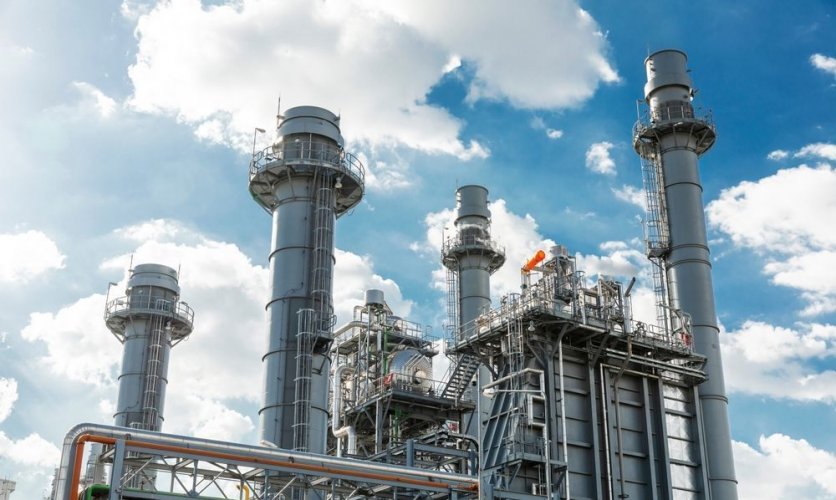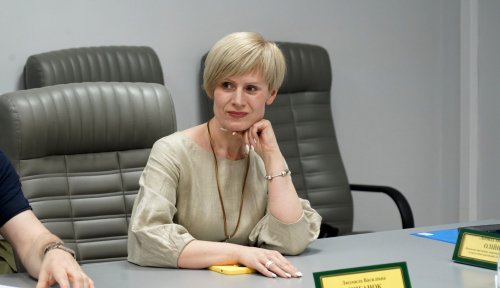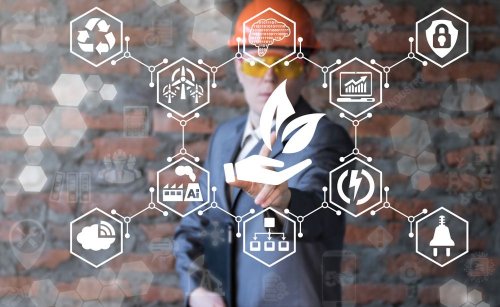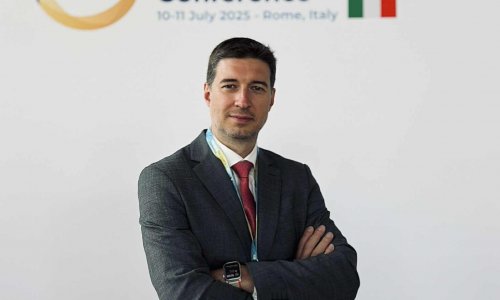On August 8 this year, the Law of Ukraine "On Integrated Industrial Pollution Prevention and Control" came into force. In the very first paragraph of this document, the lawmakers declared the implementation of the best available technologies and management practices (BAT) in Ukraine.
Ukrainian enterprises have started counting down the time they have to obtain integrated environmental permits (IEPs) and switch to BAT.
EcoPolitic has prepared a material that will help you quickly understand this new approach to production processes in Ukraine, understand how it will affect the environment, and realize the challenges that domestic enterprises face in this regard.
What is BAT
Best Available Techniques and Management Practices (BAT) are the most effective technologies currently available for environmental protection. They are developed taking into account both the specifics of individual industrial sectors and economic feasibility. These are also the methods of operating industrial facilities that ensure the avoidance or, if this is not possible, reduction of pollution and harmful environmental impact.
In all English-language documents, BATs are referred to as BATs – Best Available Techniques. Keep this in mind when working with foreign sources on this topic.
BAT is one of the key elements of Directive 2010/75/EU on industrial pollution (integrated pollution prevention and control) (Industrial Emissions Directive 2010/75/EU – abbreviated as IED). Since this term is complex, we are going to decipher what exactly the authors of the document meant:
Best – the most effective in terms of environmental protection.
Available – developed to a scale currently enabling their implementation in a specific industrial sector; they possess practically achievable economic and technical conditions considering costs.
Techniques and management methods – applied technologies, as well as technologies for the design and construction of installations, matters of operation, and decommissioning.
How Europe is implementing best available techniques and management practices
The concept of BAT first appeared in Directive 84/360/EEC back in 1984. This directive was developed to combat air pollution from industrial enterprises. It referred to "best available techniques not involving excessive costs" (BATNEEC). The current Directive 2010/75/EU on industrial emissions is one of the more progressive successors to Directive 84/360/EEC.
The main goal of BAT implementation by enterprises is to achieve ambitious low levels of pollution of all environmental elements caused by production activities.
The development and updating of the best available technologies and management practices is ongoing in the EU. This process of continuous improvement is known as Seville, after the Spanish city where the European Office for Integrated Pollution Prevention and Control has been operating since 1997. Ukraine has been participating in this process as an observer since 2023.
Under the Seville Process, officials, industry and civil society representatives work together on an ongoing basis to review BAT. They exchange information on the best available technologies and management practices between EU countries and industry to ensure that each EU country implements the requirements of the 75th Directive in the most efficient way.
As a result, environmental requirements for industrial enterprises and emission reductions are continuously updated. For example, in December 2024, the European Commission introduced updated BAT conclusions for steel mills and foundries.
Following the official implementation of the new regulations, European companies are gradually implementing the updated BAT into their own production processes.
How it works in practice
When you try to understand the terms and concepts related to BAT, you will come across the following key ones:
-
BAT (Best Available Techniques) itself;
-
BAT Conclusions;
-
BREFs (BAT Reference Documents).
Let us explain their essence.
BAT
This is a general term describing the technologies and approaches considered most effective for reducing negative environmental impact, taking into account their technical and economic feasibility.
BREF
The main source of information on such technologies and approaches is the BAT Reference Documents (BREFs), which are detailed sectoral documents prepared at the EU level as part of the previously mentioned Seville Process and are its result. BREFs describe production processes, technologies, emission levels, resource consumption, and other characteristics. Each BREF consists of 250-1000 pages.
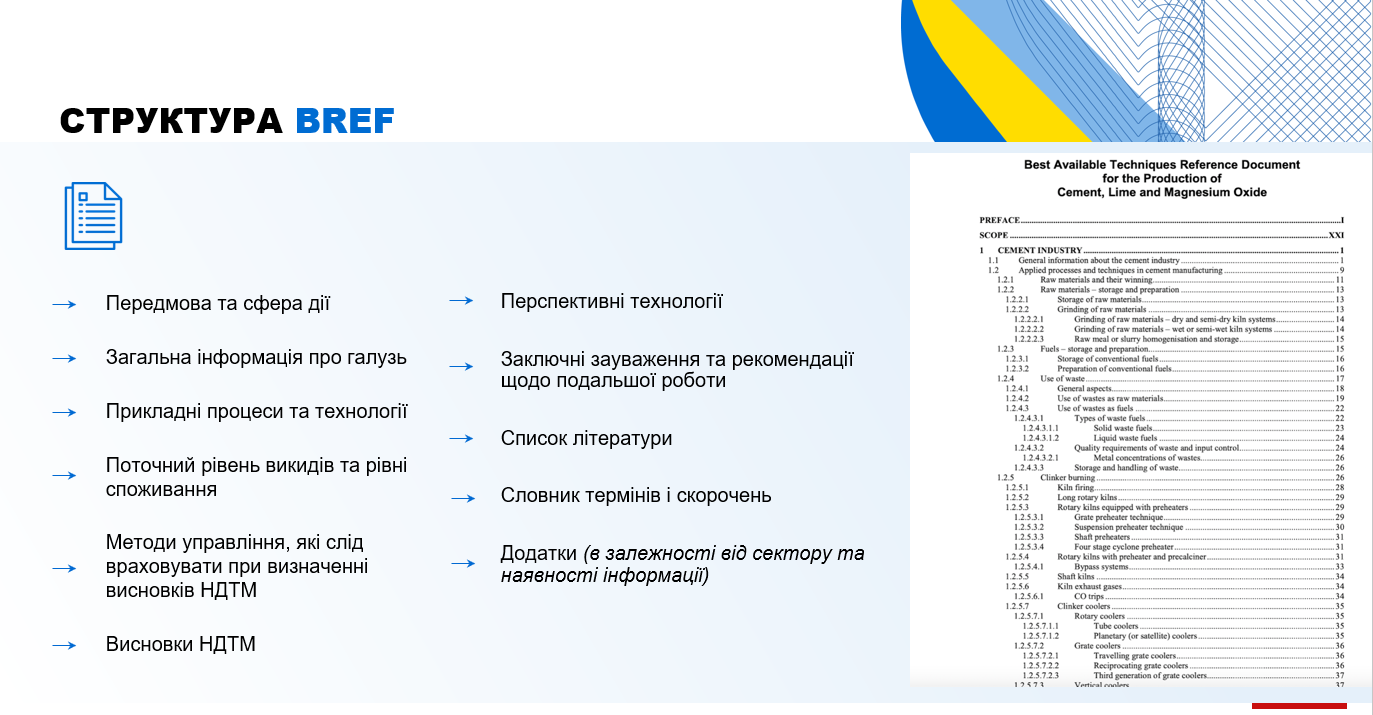
Slide from a presentation prepared by the German governmental company Deutsche Gesellschaft für Internationale Zusammenarbeit (GIZ) GmbH. Source: mepr.gov.ua.
Most BREFs cover specific industrial activities and are referred to as "sectoral BREFs". However, there are also a number of "horizontal BREFs" that address cross-sectoral issues such as energy efficiency, industrial cooling systems, or storage emissions that are relevant to industrial production as a whole.
So far, 36 BREFs have been developed in the EU. These reference documents are reviewed approximately every 8 years.
Conclusions of the BAT
Based on the BREFs, the European Commission adopts BAT Conclusions or BATCs – official documents with specific requirements for enterprises: emission limit values (BAT-AELs), monitoring methods, and rules for the use of technologies.
BAT conclusions are the basis for setting emission limit values and issuing permits for installations covered by Annex I of the Industrial Emissions Directive.
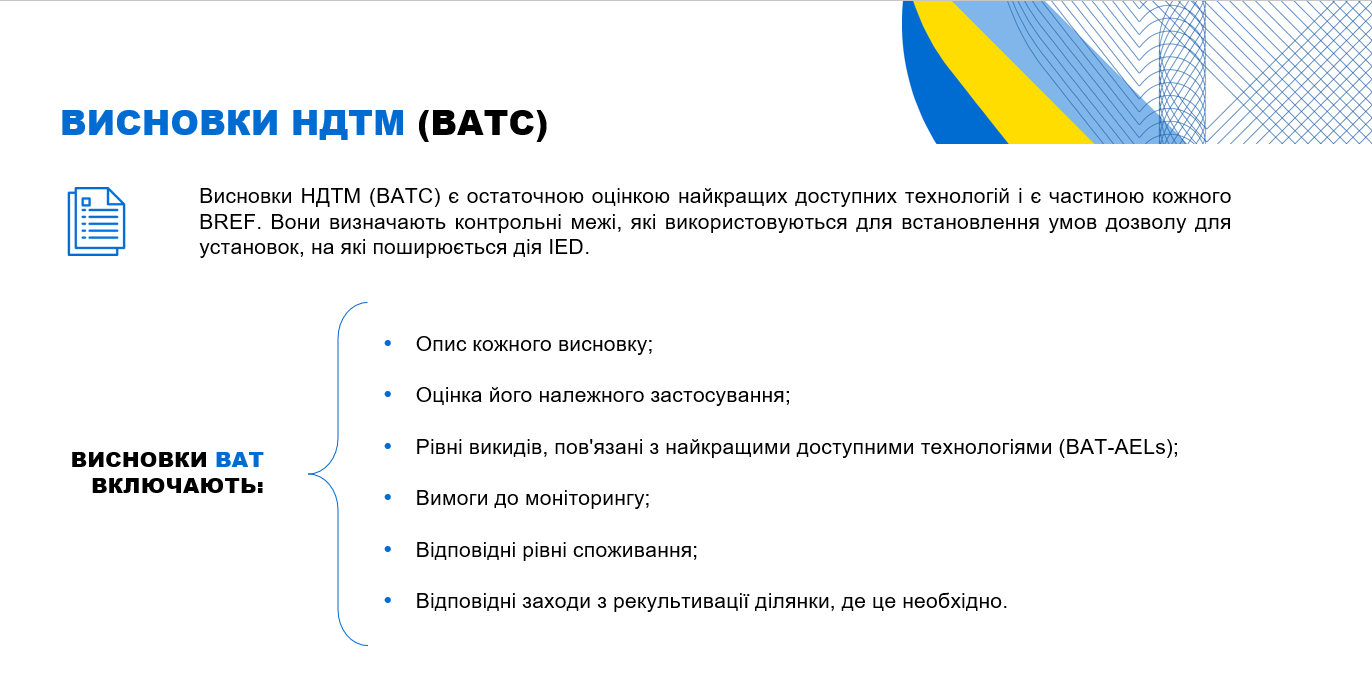
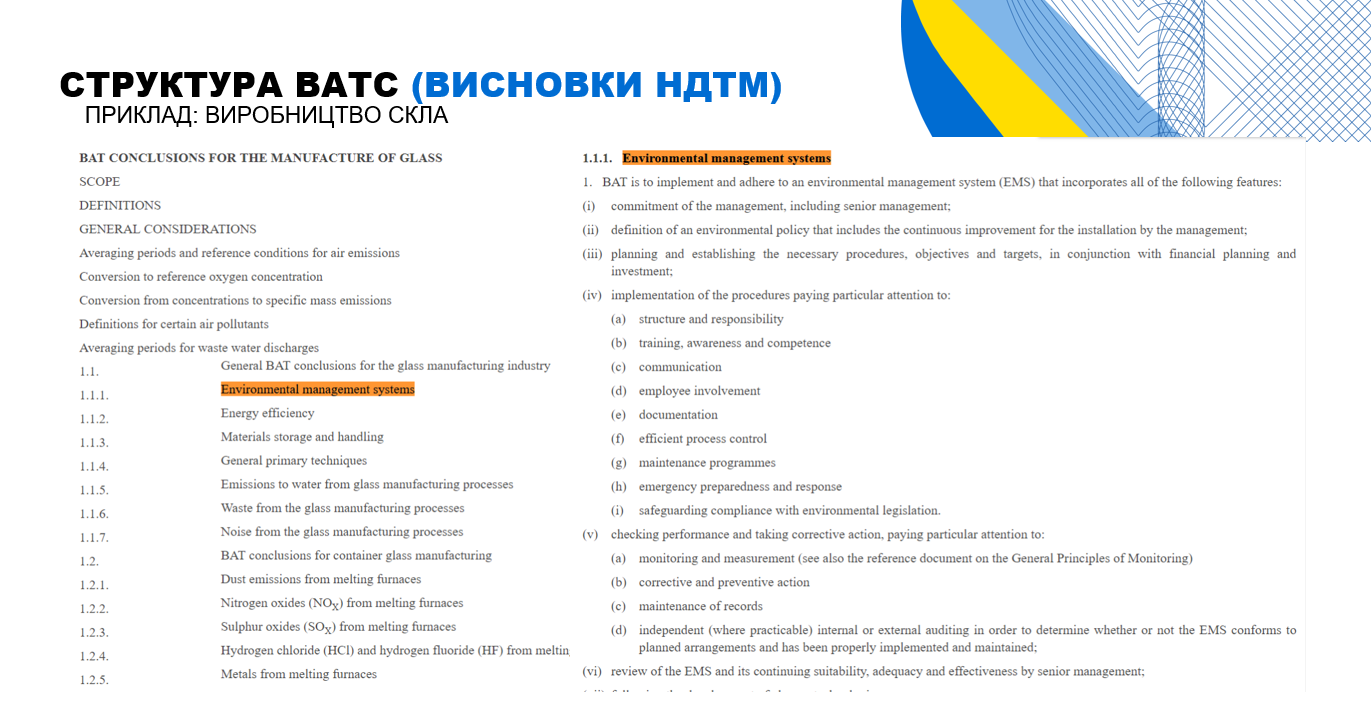
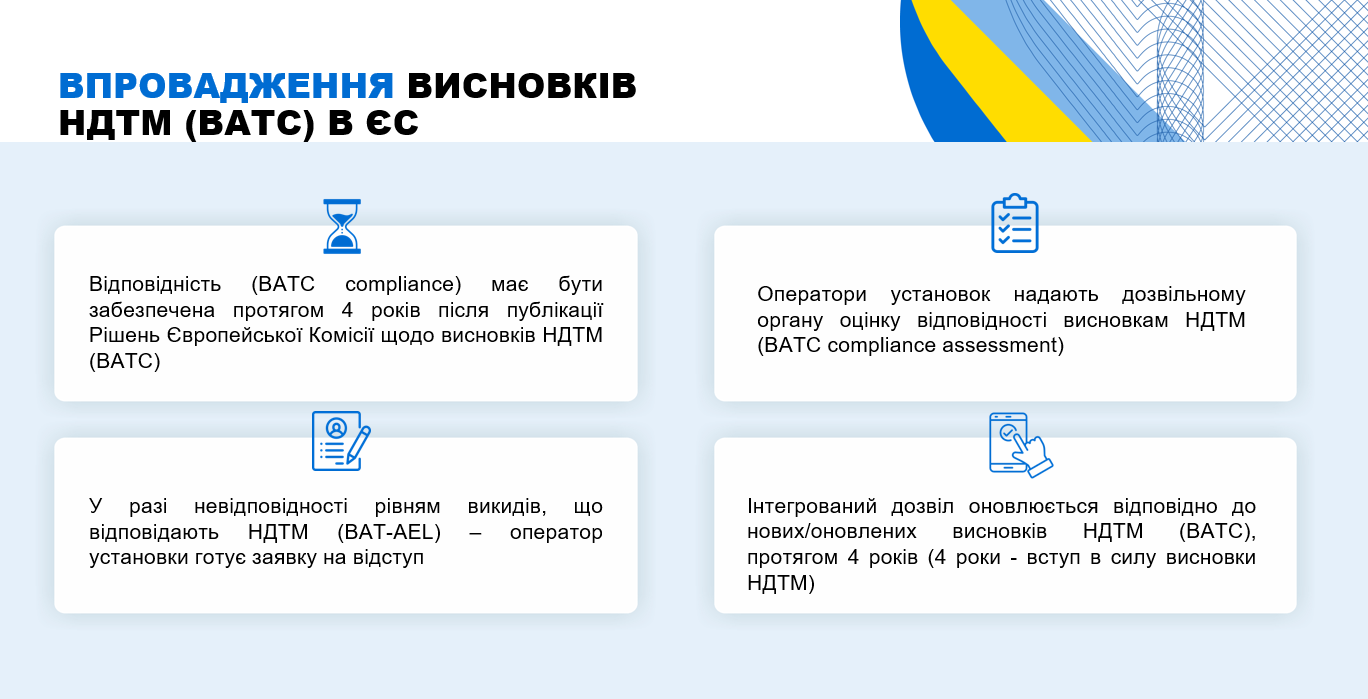
Slides from the presentation prepared by the German government company Deutsche Gesellschaft für Internationale Zusammenarbeit (GIZ) GmbH. Source: mepr.gov.ua.
While BAT is more of a concept and a guideline, and BREF is a reference book that systematizes this information, BAT conclusions are legally binding and are used to set the conditions for integrated environmental permits.
Currently, there are 22 BAT conclusions in the European Union. These documents set emission standards for installations in various industries.
What industries are required to implement BAT?
There are more than 52 thousand industrial facilities in the EU that are subject to the Industrial Emissions Directive.
These include:
-
power plants;
-
oil refineries;
-
steel production;
-
non-ferrous metal production;
-
cement production;
-
lime production;
-
glass production;
-
chemical production;
-
pulp and paper production;
-
food and beverage production;
-
waste treatment facilities, including waste incineration;
-
facilities for the intensive rearing of poultry or pigs.
All of them are required to use the best available techniques and management practices. BAT is the EU’s key instrument for regulating their emissions.
Implementation of BAT in Ukraine
The definition of best available technologies and management practices first appeared in Ukrainian legislation back in 1991 in Article 31-1 of the Law of Ukraine "On Environmental Protection". It stipulates that BAT conclusions in Ukraine are developed and approved on the basis of EU legislation.
"The content, form and structure of the conclusions of the best available technologies and management methods shall correspond as fully and accurately as possible to the content, form and structure of the relevant act of the European Union legislation," the Law states.
But then it did not go further than definitions and terms. The issue became more acute in 2014, after Ukraine signed the Association Agreement with the EU. One of our country's obligations under this document was to implement Directive 2010/75/EU of the European Parliament and of the Council on industrial pollution (integrated pollution prevention and control).
How Ukraine spent years progressing toward adopting the framework law
In 2015, the National Strategy for Approximation of Ukrainian Environmental Legislation to EU Law was adopted to approximate Ukrainian legislation to EU environmental law. Paragraph 5.7 of this document states that "in order to ensure the implementation of the provisions of Directives 2010/75/EU and 96/82/EU, it is necessary to translate and provide general access to BAT guidelines (BREF) and European Commission decisions on BAT".
It was assumed that 2 years after the entry into force of the Association Agreement, i.e. by the end of 2016, it would be available:
-
national legislation would be adopted and a competent authority designated to implement the Industrial Emissions Directive;
-
a concept for implementing an integrated permitting system and a draft law on integrated permits would be developed.
By the end of 2019, the following were planned:
-
to create a mechanism for monitoring compliance with integrated permit conditions;
-
to identify industrial facilities requiring an integrated environmental permit (IEP);
-
to introduce BAT standards based on the conclusions of BREF reference documents.
The implementation of the Industrial Emissions Directive was undertaken by the Ministry of Ecology and Natural Resources of Ukraine (MENR). In November 2018, it presented the Concept for Implementing State Policy in the Field of Industrial Pollution for public discussion. This document was a necessary prerequisite for the subsequent drafting of a law “On the Prevention, Reduction, and Control of Industrial Pollution”, which was planned for 2019-2020. This meant Ukraine was already several years behind the schedule set in the Association Agreement.
In December 2019, the draft law on industrial pollution was published. In February of the following year, it was submitted to the Verkhovna Rada of Ukraine, but within less than two weeks, it was withdrawn.
At the end of September 2020, the government draft law No. 4167 “On the Prevention, Reduction and Control of Pollution Arising from Industrial Activities” was registered in parliament. It was received extremely negatively by business representatives. Experts considered the draft law to be inconsistent with Directive 2010/75/EU. As a result, the members of parliament rejected it.
Later, three alternative draft laws, No. 4167-1, 4167-2, and 4167-3, were proposed by members of parliament, but none of them were put to a vote.
This group of documents was subsequently replaced by another. In December 2022, the Committee of the Verkhovna Rada of Ukraine on Environmental Policy and Nature Management considered draft law No. 6004 “On Integrated Prevention and Control of Industrial Pollution” and three alternatives – No. 6004-1, 6004-2 and No. 6004-d. The latter became the main one and was designated as a Eurointegration draft law. However, even this one failed in parliament – the document received 225 votes out of the required 226.
On the same day when the draft law No. 6004-d failed to pass, the members of parliament made a “sleight of hand” and re-registered its text under a new number – 11355, which constitutes a violation of the regulations. On July 16, 2024, it was adopted in the second reading. This regulatory act laid the legal foundation for the application of BAT standards in various industrial sectors.
Thus, with the adoption of this framework document, lawmakers were at least four years late.
Which subordinate acts are already prepared
Since the BAT concept is one of the key concepts in the 75th EU Industrial Pollution Control Directive, it is not surprising that the Law of Ukraine "On Integrated Industrial Pollution Prevention and Control" is based on it. According to Article 3 of this Law, an integrated environmental permit is issued in accordance with the conclusions of the BAT. An application for an IED (or amendments thereto) must also contain an assessment of compliance with the best available technologies and management practices. Accordingly, the conditions of the integrated environmental permit are determined in accordance with the BAT conclusions.
According to the Ukrainian government, officials have approved all the regulations necessary to implement the provisions of the Law.
Ukraine only started actively working on the translation and harmonization of the terminology of the BAT conclusions in 2022. In December of that year, the Ministry of Environmental Protection and Natural Resources was the first to publish the Energy Efficiency BREF.
Currently, 10 BAT documents have been translated into Ukrainian. These include 8 sectoral and 2 horizontal documents:
-
Sectoral BREFs:
-
Ferrous metals processing industry.
-
Iron and steel production.
-
Non-ferrous metals processing industry.
-
Forging and foundry industries.
-
Surface treatment of metals and plastics.
-
Cement, lime, and magnesium oxide production.
-
Glass production.
-
Ceramics industry.
-
Horizontal BREFs:
-
Energy efficiency.
-
Monitoring emissions from installations covered by the IED 75.
However, the procedure for the development and approval of BAT conclusions, as well as for publishing reference Best Available Techniques and Management Methods (BREFs), was adopted by the Cabinet of Ministers of Ukraine only at the end of January this year.
Its main provisions are as follows:
-
BAT conclusions are developed as translations of official EU conclusions.
-
This translation is financed from the budget, donor funds, and technical assistance.
-
The documents must be identical to the EU conclusions (in terms of structure, content, tables, and graphics).
-
Draft BAT conclusions are discussed in working groups involving government, business, and the public (discussion period – up to 45 days).
-
The relevant ministry approves them and publishes them on the web portal of the Unified State Register of Integrated Environmental Permits, as well as on its official website.
-
At the same time, the corresponding reference background document is published in the same manner as the approved conclusions.
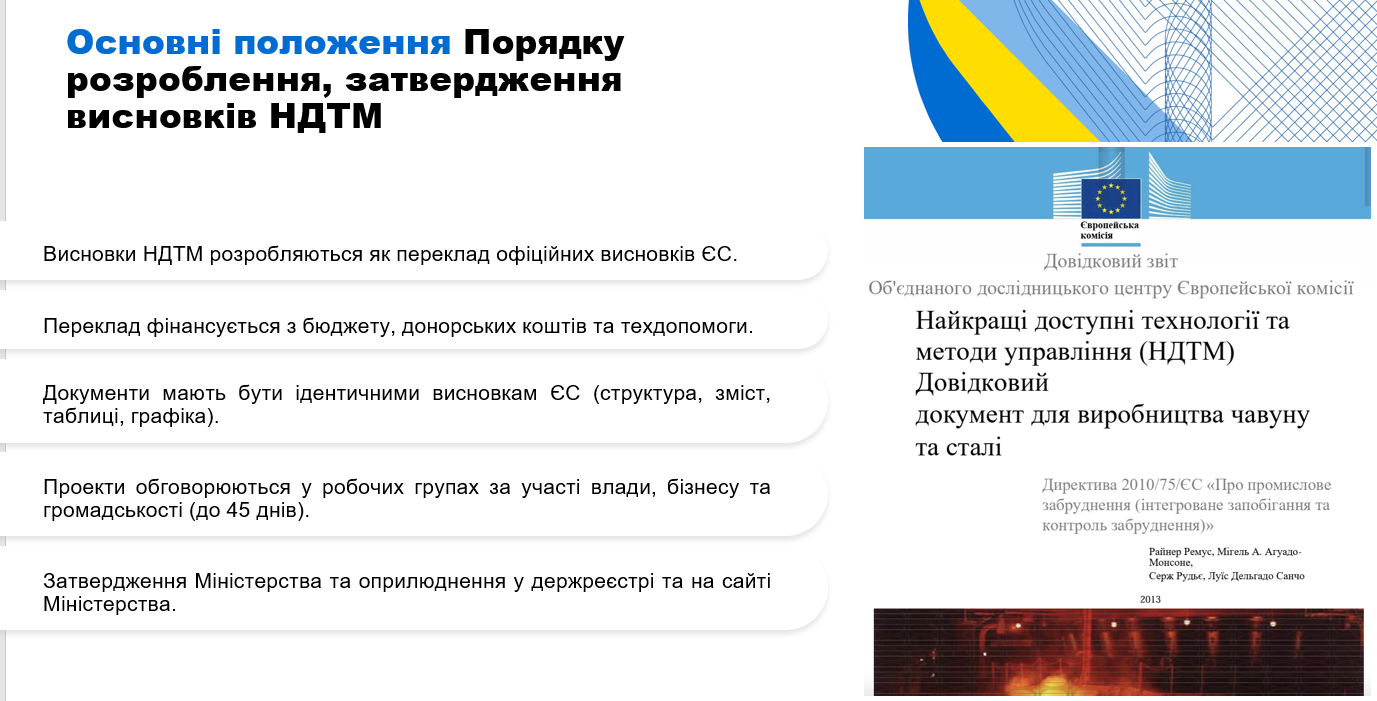
Slide from a presentation prepared by the German government company Deutsche Gesellschaft für Internationale Zusammenarbeit (GIZ) GmbH. Source: mepr.gov.ua.
The Law of Ukraine "On Integrated Prevention and Control of Industrial Pollution" also stipulates that the relevant ministry shall update BAT conclusions no later than 12 months after the date of official publication of the relevant acts in the EU.
How companies can prepare for BAT implementation
According to Art. 29 of the Law of Ukraine "On Integrated Prevention and Control of Industrial Pollution", the application of BAT conclusions for facilities that have already been put into operation will begin no earlier than 4 years after the date of termination or cancellation of martial law, and for facilities that are put into operation for the first time – from the date such conclusions come into force. In other words, all new facilities commissioned after August 8, 2025, must comply with European environmental requirements in accordance with the BAT conclusions.
For all existing facilities, the existing permits for emissions, special water use and waste management will expire from the date of obtaining the integrated permit, but no later than 4 years after the Law comes into force, i.e. on August 8, 2029.
During the 4-year transition period, operators of installations subject to the industrial pollution law will be allowed, until obtaining the IEP, to continue applying for separate permits for atmospheric pollutant emissions, special water use, and waste treatment operations.
The Ministry of Environmental Protection has identified 4 “types” of installations for which the transition periods to IEP will differ. For more details on this, see our article.
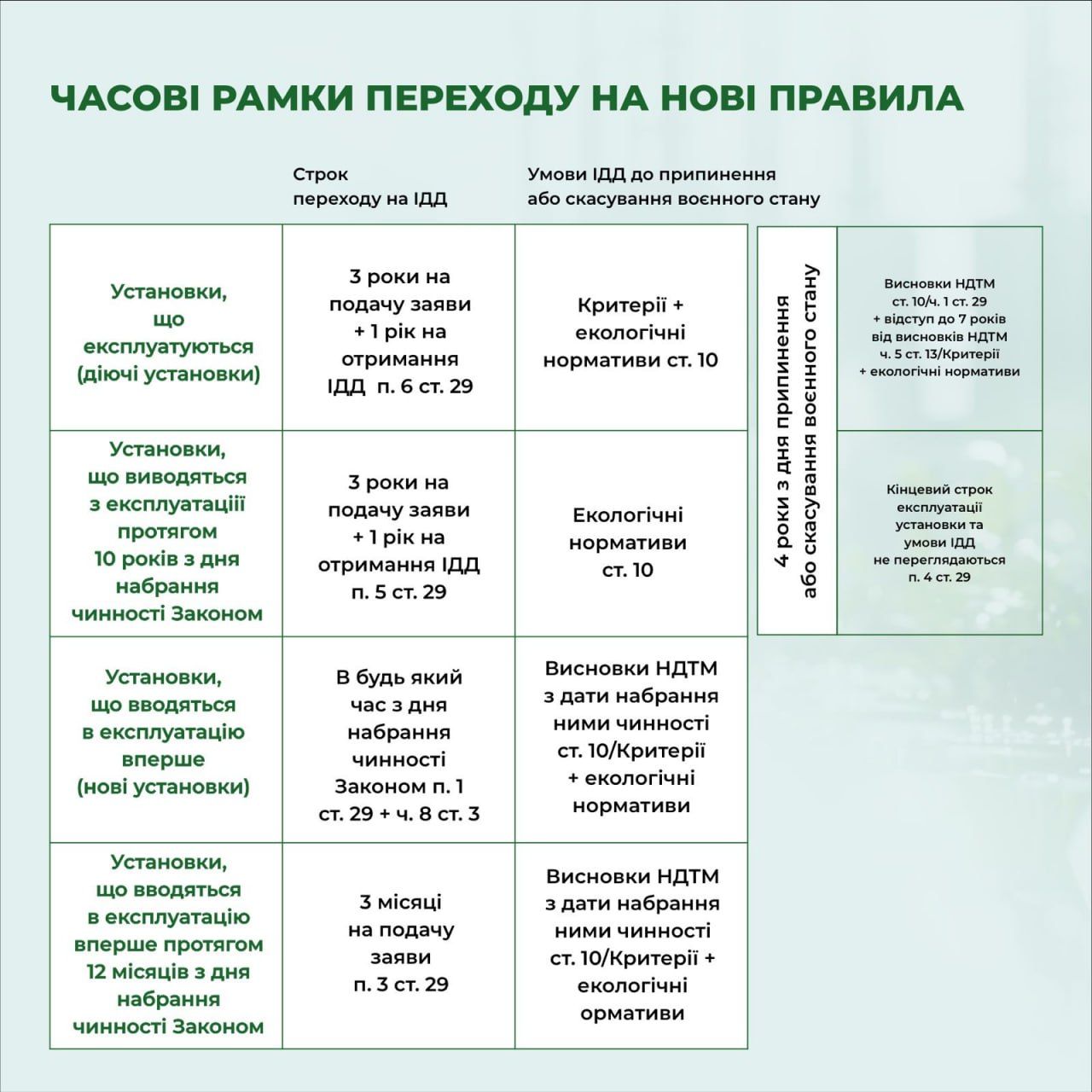
Source: t.me/mindovkillia.
The next important task for the implementation of Directive 75 in Ukraine is to adopt the BAT conclusions. On the one hand, they will specify the requirements for enterprises, and on the other hand, they will help reduce the negative impact of industrial facilities on the environment.
We are also looking forward to the launch of the IT system for issuing the IDD, which will be launched on the EcoSystem platform. The Ministry of Economy, Environment and Agriculture of Ukraine reported on its creation back in August.
Who can get a derogation from BAT
Article 13 of the Law of Ukraine "On Integrated Prevention and Control of Industrial Pollution" stipulates that the permitting authority may determine for a particular facility less stringent maximum permissible emissions than the standards set in the conclusions of the best available technologies and management methods. This is a derogation.
It is granted if there are effective BAT conclusions for the relevant type of activity carried out at the facility and is applied from the date specified in such conclusions.
A derogation may be granted in two cases:
-
the initial receipt of an integrated environmental permit for an installation that is already in operation;
-
when updating the terms of the IED in cases provided for in points 1 and 2 of the first part of Article 23 of this Law.
A derogation is granted for the duration of specific measures defined by the conditions of the IED and may not exceed 7 years from the date the BAT conclusions, for which the derogation is granted, take effect. The period of the granted derogation cannot be extended.
For more details on how to determine whether an installation has the right to deviate from the BAT conclusions and how to obtain it, please read our material. It should be noted that despite the government's declaration of full readiness of subordinate regulatory acts, the approved resolution of the Cabinet of Ministers of Ukraine entitled "On Approval of Requirements for the Development, the form and content of the assessment of the deviation and indicators of the criterion of disproportionately high cost of achieving the maximum permissible emissions determined in the conclusions of the best available technologies and management methods, compared to the benefits for the environment, as well as the methodology for calculating the cost of achieving the maximum permissible emissions determined in the conclusions of the best available technologies and management methods, in relation to the environmental benefits," which the Ministry of Environment developed and published back in June, EcoPolitics journalists were unable to find.
Checklist for Enterprises to Prepare for BAT Implementation
-
Check whether your sector is included in the list of those requiring BAT implementation.
-
Familiarize yourself with the relevant BREF reference document. Find out which technologies and methods are recognized as best in the EU for your sector.
-
Conduct a production audit. Assess the current state of equipment, processes, and environmental impact.
-
Develop a modernization plan: determine what needs to be upgraded or replaced to comply with BAT requirements.
-
Calculate the budget for necessary environmental investments and plan these expenditures along with other expenses of the enterprise.
-
Prepare the documents required to obtain the integrated environmental permit and submit an application for its issuance. The list of documents and the information to be included in the application can be found here.
-
Conduct internal training sessions for employees so they know how to work according to the new rules.
-
Monitor new developments by tracking updates in reference materials, legislative changes, and new recommendations or trainings from the Ministry of Economy on integrated environmental permits and best available techniques.

